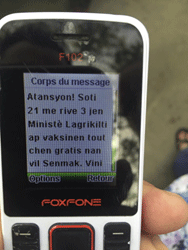Home \ Knowledge Hub \ Opinion \ Technology and Networks – a Holistic Approach to Controlling Diseases


01 May 2018
Technology and Networks – a Holistic Approach to Controlling Diseases
SHARE

ALASDAIR KING
Executive Director, International Veterinary Health
Innovation and the use of technology sees an increase in dog owners attending a vaccination drive. Conferences on rabies control see a developing network working together, and GALVmed looks at how to make a lasting impact in Africa. It’s been an exciting start to the year.
New year, a new approach

Despite the snowstorms hitting the USA and a lot of Europe during the first months of this year, we have managed to travel to a number of important meetings. I think I see a change in these meetings, how we talk to each other and how we are focusing on the issues ahead in controlling transboundary and emerging diseases. Rather than focusing on individual diseases, individual countries, or individual problems, we are starting to learn from one another and apply all those learnings into effectual interventions.
A holistic ‘One Health’ approach, we can maximize our impact, making disease control and elimination possible. We are dedicated to being part of this change.
It’s an exciting change. This is a great time to be working together in this field. As we develop a holistic ‘One Health’ approach, we will maximize our impact, making disease control and elimination possible. Our team is dedicated to being part of this change.
SMS Text Alerts for Vaccination Campaigns

Last year, we worked with the Centers for Disease Control and Prevention (CDC) on a new initiative to increase dog-owner participation in a vaccination campaign in Haiti. For a few years, I have been frustrated by the sometimes low number of owners bringing their dogs for free vaccination. There are a number of reasons behind this, and education is definitely an important one. But, since having moved to the US, I have become aware of community alerts sent out by SMS to warn people of dangerous weather or of criminal activity. This isn’t something that occurs in the UK. During a meeting with the CDC, I received one of these alerts and that prompted the idea that maybe this would be a way to let people know about vaccination. We tried it out in Haiti and were very pleased with the results, with a significant increase in the number of people attending the central point vaccination stands. The paper is now available here
To increase dog-owner participation in a rabies campaign in Haiti we used SMS messages and we were pleased to see a significant increase in attendance of the central point vaccination stands
GALVmed in Morocco
I don’t normally manage to get to the March meeting of the Global Alliance for Livestock Veterinary Medicines (GALVmed) because, in the past, it clashed with the OIE sub-commission South-East Asia and China Foot and Mouth Disease (SEACFMD) meeting. However, with that conference having been moved to the end of the year, I was able to join the other GALVmed members in Casablanca, Morocco. This was a great opportunity because we had some very positive discussions on how we can all work together to help improve access to medicines in Africa. If we are going to be successful in this, then it can’t be done by one individual or group, we need to find a real partnership model that will build a sustainable structure throughout the continent.

CDC Rabies Elimination Workshop
After a brief turnaround from Morocco, I headed down to Atlanta and a week-long workshop at the Centers for Disease Control and Prevention (CDC). Walking around the museum there and reading about the control of Ebola and smallpox was inspirational and helped us think about how we can use limited resources in the best way. There is a real balance between saving lives now and making a difference in the long term. Vaccinating dogs is shown to save human lives, and we can’t let up on that, but we need education on both the disease and also the human:dog interaction to ensure we have a healthy relationship.
ARACON
While I was in Casablanca, John Atkinson was in Bangkok for the first ARACON meeting. ARACON, Asia Rabies Control Network, is modelled on the successes of PARACON, the Pan African Rabies Control Network. This initiative has been led by the Global Alliance for Rabies Control (GARC). There was some important discussion on various vaccination strategies and how these need to be tailored to dog population types. Not all dogs are equal when it comes to the potential of transmitting rabies, and we can improve the efficacy of our campaigns by getting a better understanding of this. Judging by the interest and enthusiasm shown by the participants during this first meeting, ARACON gives cause for optimism in the fight against rabies in Asia.
ALASDAIR KING
Executive Director, International Veterinary Health

